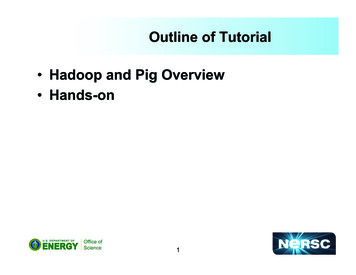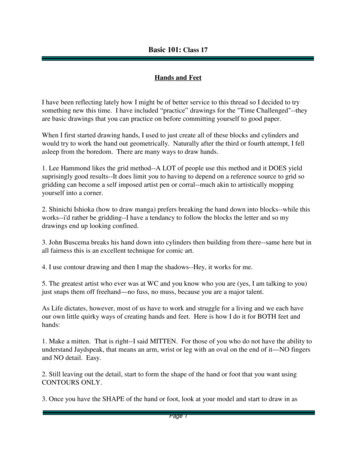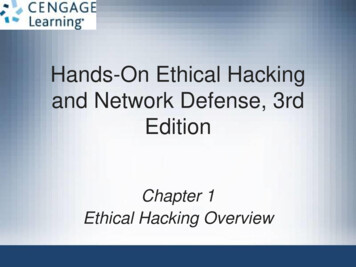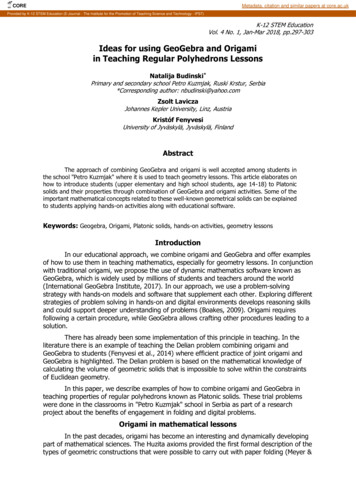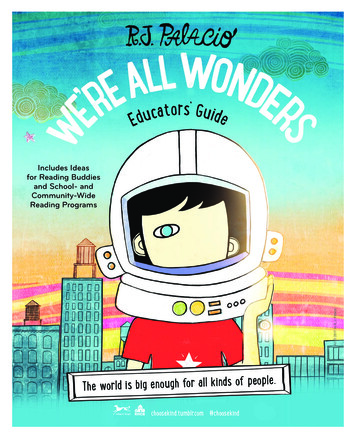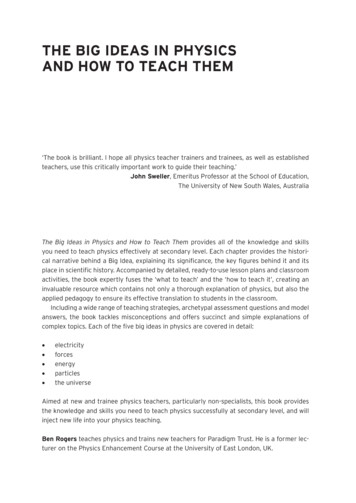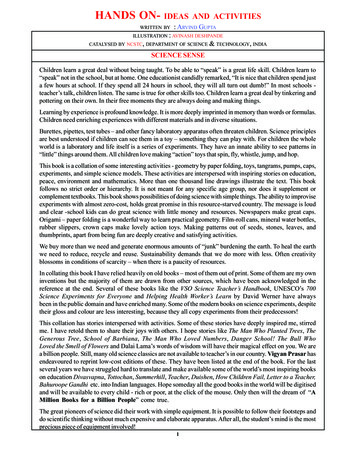
Transcription
HANDS ON-IDEAS AND ACTIVITIESWRITTEN BY: ARVIND GUPTAILLUSTRATION : AVINASH DESHPANDECATALYSED BY NCSTC, DEPARTMENT OF SCIENCE& TECHNOLOGY, INDIASCIENCE SENSEChildren learn a great deal without being taught. To be able to “speak” is a great life skill. Children learn to“speak” not in the school, but at home. One educationist candidly remarked, “It is nice that children spend justa few hours at school. If they spend all 24 hours in school, they will all turn out dumb!” In most schools teacher’s talk, children listen. The same is true for other skills too. Children learn a great deal by tinkering andpottering on their own. In their free moments they are always doing and making things.Learning by experience is profound knowledge. It is more deeply imprinted in memory than words or formulas.Children need enriching experiences with different materials and in diverse situations.Burettes, pipettes, test tubes – and other fancy laboratory apparatus often threaten children. Science principlesare best understood if children can see them in a toy – something they can play with. For children the wholeworld is a laboratory and life itself is a series of experiments. They have an innate ability to see patterns in“little” things around them. All children love making “action” toys that spin, fly, whistle, jump, and hop.This book is a collation of some interesting activities - geometry by paper folding, toys, tangrams, pumps, caps,experiments, and simple science models. These activities are interspersed with inspiring stories on education,peace, environment and mathematics. More than one thousand line drawings illustrate the text. This bookfollows no strict order or hierarchy. It is not meant for any specific age group, nor does it supplement orcomplement textbooks. This book shows possibilities of doing science with simple things. The ability to improviseexperiments with almost zero-cost, holds great promise in this resource-starved country. The message is loudand clear -school kids can do great science with little money and resources. Newspapers make great caps.Origami – paper folding is a wonderful way to learn practical geometry. Film-roll cans, mineral water bottles,rubber slippers, crown caps make lovely action toys. Making patterns out of seeds, stones, leaves, andthumbprints, apart from being fun are deeply creative and satisfying activities.We buy more than we need and generate enormous amounts of “junk” burdening the earth. To heal the earthwe need to reduce, recycle and reuse. Sustainability demands that we do more with less. Often creativityblossoms in conditions of scarcity – when there is a paucity of resources.In collating this book I have relied heavily on old books – most of them out of print. Some of them are my owninventions but the majority of them are drawn from other sources, which have been acknowledged in thereference at the end. Several of these books like the VSO Science Teacher’s Handbook, UNESCO’s 700Science Experiments for Everyone and Helping Health Worker’s Learn by David Werner have alwaysbeen in the public domain and have enriched many. Some of the modern books on science experiments, despitetheir gloss and colour are less interesting, because they all copy experiments from their predecessors!This collation has stories interspersed with activities. Some of these stories have deeply inspired me, stirredme. I have retold them to share their joys with others. I hope stories like The Man Who Planted Trees, TheGenerous Tree, School of Barbiana, The Man Who Loved Numbers, Danger School! The Bull WhoLoved the Smell of Flowers and Dalai Lama’s words of wisdom will have their magical effect on you. We area billion people. Still, many old science classics are not available to teacher’s in our country. Vigyan Prasar hasendeavoured to reprint low-cost editions of these. They have been listed at the end of the book. For the lastseveral years we have struggled hard to translate and make available some of the world’s most inspiring bookson education Divasvapna, Tottochan, Summerhill, Teacher, Duishen, How Children Fail, Letter to a Teacher,Bahuroope Gandhi etc. into Indian languages. Hope someday all the good books in the world will be digitisedand will be available to every child - rich or poor, at the click of the mouse. Only then will the dream of “AMillion Books for a Billion People” come true.The great pioneers of science did their work with simple equipment. It is possible to follow their footsteps anddo scientific thinking without much expensive and elaborate apparatus. After all, the student’s mind is the mostprecious piece of equipment involved!1
THE HEIGHT OF IT!Clever students seldom do things the intended way!The graduate class was asked the following question as part of the final exampaper in Copenhagen University: “How will you find the height of a skyscraperusing a barometer?”One student answered: “I will hang the barometer with a long rope from thetop of the building . Once the barometer touches the ground then I will measurethe length of the rope. I will add the height of the barometer to the length ofthe rope to determine the height of the skyscraper.”The examiner felt almost offended after reading this very original solution.He got very angry and failed the student. The aggrieved student appealedto the University and pleaded that his answer was correct and if any proofwas required it could be tested. The University was in a fix. It appointed anexternal, neutral examiner to objectively and dispassionately unravel the truth.After a deep probe the external examiner gave his verdict: “Though thestudent’s answer is correct it does not reflect any deep understand of physics.”So it was decided to call the student for a six-minute interview to test hisunderstanding and grasp of the basic principles of physics.During the interview, the student sat absolutely silent with his head hung lowfor the first five minutes. When the examiner reminded him of the time limitthe student replied, “Sir, I know of several elegant solutions. But I am unableto decide on the most appropriate one!”On being coaxed by the examiner the boy gave a quick reply:“Well, you can drop the barometer from the top of the skyscraper.Measure the period ‘t’ of fall. Then using the equation H 0.5 g x t x tcalculate the height of the building. In this experiment the barometer, of course,will get smashed to pieces.Or else, if it is a sunny day, then you can first measure the actual height of thebarometer and the length of its shadow. Next you measure the length of theshadow cast by the skyscraper. Later, using simple arithmetic and the principleof similar triangles you can find the height of the skyscraper.But if you wish to use a very precise scientific method then tie the barometerto the end of a short string and swing it like a pendulum - first on ground andthen on roof of the building. The height of the skyscraper can then bedetermined by using the simple equation for finding the time period of a simplependulum.But if the skyscraper has an emergency staircase then the task will be mucheasier. While climbing up the stairs keep measuring the height of the buildingusing the barometer like a scale. Later you can add them up to calculate theheight of the skyscraper.But if you wish to adopt a very conventional and boring way then using thebarometer you can measure the difference in the atmospheric pressure on theground and the top of the building. This difference in air pressure given in“milli-bars” can later be converted into feet to give the height of the building.But students are always asked to use their own original and independent ideasto learn science, so the best solution would undoubtedly be to go to the securityguard of the building and tell him, ‘Here, you can have this brand new barometer,but first you will have to tell me the height of the building!’”The name of this student was Neils Bohr - the first and only person fromDenmark to win a Noble Prize in Physics.(Pix: Abha Mehrotra)2
THE PARADOX OF OUR TIMESIs that we have taller buildings, but shorter tempersWider freeways, but narrower viewpointsWe spend more, but we have lessWe have bigger houses, but smaller familiesMore conveniences, but less timeWe have more degrees, but less senseMore knowledge, but less judgementMore experts, but more problemsMore medicines, but less wellnessWe have multiplied our possessions, but reduced our valuesWe talk too much, love too seldom, and hate too oftenWe have learnt how to make a living, but not a lifeWe have added years to life, but not life to yearsWe’ve been all the way to the moon and backBut have trouble crossing the street to meet the new neighbourWe have conquered outer space, but not inner spaceWe’ve cleaned up the air, but polluted our soulWe’ve split the atom, but not our prejudiceWe’ve higher incomes, but lower moralsWe’ve become long on quantity but short on qualityThese are the times of tall men, and short characterSteep profits, and shallow relationshipsThese are the times of world peace, but domestic warfareMore leisure, but less fun; more kinds of food, but less nutritionThese are the days of two incomes, but more divorcesOf fancier houses, but broken homesIt is a time when there is much in the show windowAnd nothing in the stockroomA time when technology can bring this letter to youAnd a time when you can chooseEither to make a difference. or just hit, delete.- His Holiness the Dalai Lama3
THUMBPRINTSThumbprints can be amazing fun. Try some!Of all the littlethings we seekOur thumb appears,to be unique.Have you seenyour own thumbprint?It has aunique imprint.No two thumbprints,look the same.But they makea very good game.Six billion people,throng the globe.Each with aunique thumb lobe.Every thumbprint,in the world,Has different lines,different whorls.Print your thumb,look up or down.You might find,in it a clown.A bird, a lion,a crawling snail.A fish, a peacock,snorting whale.In your thumbprint,you will find.Lots of things,to open the mind.4
5
THE GENEROUS TREEThe most inspiring “green” tale ever. Adaptation of Shel Silverstein’s classic The Giving Tree.Once there was a tree and a little boy. The tree loved the boy verymuch. Everyday the boy played under the tree. He picked up flowersand made them into a garland. He climbed the tree trunk and swungfrom its branches. He played hide and seek with the squirrels andtalked to the birds. By afternoon he got very tired. Then he sleptunder the shade of the tree. Whenever he felt hungry he ate thefruits of the tree. The boy loved the tree too. But time flew by. Andthe boy grew up. Then he stopped coming to the tree. The tree feltvery sad and lonely.After many years one day the boy came to the tree. The tree wasoverjoyed to see him. He said, “Come boy, come play and havefun. Climb on my trunk and swing from my branches.” The boysaid, “I don’t have time for that anymore. I want some money. Iwant to go to the bazaar and buy something. Can you give me somemoney?” The tree replied, “I don’t have any money to give you.But you can pluck my fruits and sell them in the market. Then youwill have the money to buy what you want.” So the boy took all thefruits. The tree was happy. The boy disappeared. Years passed.One day the boy came and said, “I need a house. Soon I will bemarried and I will need a house for my wife and children.”“You can chop my branches and make a log house”, said the tree.And this is what the boy did. The tree was still happy. Now all thatremained of the tree was its tall trunk.Several years passed and the boy did not come back. The treeremembered him and felt sad. So, one day when the boy came thetree actually shook its leaves with joy. The boy was carrying a kindof executive briefcase.“What can I do for you my child?” asked the tree.“Well, I have to go on a business trip for which I need to cross thesea. I urgently need a boat. Can you give me one?”The tree thought for a while and said, “All I have left is a trunk. Youcan make a boat out of it.” So the tree lost its trunk too.All that was left of the tree was a stump.Many-many years passed. One-day one doddering old man cameup to the stump. The tree immediately recognised him to be itschildhood friend. The tree was very apologetic. It said,“Sorry, my friend I have nothing left to give you. My fruits aregone. My branches and trunk are gone. All that is left of me is alowly stump.”The old man sighed and said, “You see, I have no teeth left to eatyour fruit. Nor do I have energy left to climb up your trunk andswing from your branches. I am too old and tired. All I want is aplace to rest and relax.”“Then sit on me,” said the tree. The tree was still happy.(Pix: Dilip Chinchalkar)6
COLOUR MATCHINGThis is a simple and popular activity for little children.Make a cloth bag with several small pockets. Stitch thepockets with colour cloth. For instance, the ‘GREEN’pocket should be made from green coloured cloth. Drawcommon things on a pack of plain cards with black sketchpen. These things could include leaves, vegetables, fruitsand other common objects. Children take turns in playingthe game. They remove one card from the pack, and placeit in the right colour pocket. For instance a “brick” mightgo into the red pocket. There might be instances when itmight be possible to put the card in more than one pocket.For instance, chillies could be green or red. This could leadto an animated discussion.NUMBER MATCHINGThis activity gives children an opportunity to match numerals to actual number of things.Ask children to bring empty matchboxes from their home. Stick white paper on the outer shells and insidedrawers. Now write the number “1” on the outer shell. Draw one little circle inside the drawer. Write “one”on the back of the drawer. Do this for numerals 1 to 20. Remove the drawers from the matchboxes andmake a pile of the matchbox cases and their drawers. Children can now put the drawers in their right shells.They can arrange the matchboxes in an ascending or descending order. Many number patterns can bediscovered through these activities.WORD MATCHINGThis activity gives children an opportunity to match words to their pictures.This activity is quite similar to the numbermatching activity. On top of the matchboxshell you write the name of a commonobject. Inside the drawer you draw apicture of that thing. Then make a pileof matchbox word shells and picturedrawers and ask children to match them.(Pix: Avinash Deshpande)7
NUMBER POCKETSLittle children find this activity great fun.Make a cloth bag with ten pockets eachnumbered from 1 to 10. Make a pack ofcards with different number of objectson them. Children pick up a card, countthe number of things on it and place thecard in the right “number” pocket.SPELLING FANThese mini fans can help children remember the correctspelling of words. Take 2-cm x 8-cm rectangles of thickpaper. Make a pile of three cards. Align them and then puncha hole near the centre of the left edge. Secure the cardstogether with the help of a split pin or a press button. Nowwrite the letters B, A and G on the cards. Draw the pictureof the bag on the back of the mini-book. These are selfcorrecting cards. Children can open up the fan, read theword and then invert the fan to see the picture.FLICK KNIFEThis automatic mechanical knife - a Rampuri Chaku, is fun to make and a sheer delight to play with.1. To make the Flick Knife you will need twowooden ice-cream sticks, two small rubber bands,a matchstick and a paper knife or blade. Cut oneice-cream stick about 3-cm from one end.2. Cut notches in the pieces as shown. Taper thelong piece so that it looks like a knife blade. Cutnotches on the other ice-cream stick too, as shown.4. Now swing the blade andlock it under the small piece.3. Join the cut pieces on the big ice-cream stickby putting a rubber band in each pair of notches.Slip in a piece of matchstick between the smallpiece and the big ice-cream stick. This is thefulcrum and is part of the locking system. Youcan open and close it by pressing it.5. Now, if you press the left button, the bladewill flick open in a fraction of a second.(Pix: Avinash Deshpande)8
WHAT IS MISSING?1. You need a tray or abig thali, and lots andlots of different things.3. Then ask a friend to cover hiseyes, while you remove one itemfrom the tray. Ask your friend to openhis eyes and find the missing item.2. Lay different things onthe tray. Let a friend havea good look at them.PART AND WHOLEFOLDCELLO TAPECUTTAPELARGEPAPERBAG1. Make a picture a on a sheetwith markers. You could also usea picture from an old magazine.2. Now cut windows in a big brown envelope.Make hinged-window shutters with tape.Then slide the picture into the envelope.3. Let a friend peekat the picture throughthe windows andguess what it is.SIMPLE JIGSAW1. For making a jigsaw youwill need an old file cover,sketch-pens and a scissors.2. Draw a border aroundthe cardboard. Then drawa picture on the cardboard.3. Cut the picture into afew pieces. Ask a friendto assemble the jigsaw.BROKEN HACKSAW BLADESDo not throw away broken hacksaw blades.Wrap the raw ends with tape or an old cloth tomake a handle. Cost of tools is often a reasonwhy schools and homes have no workshops. InIndia broken hacksaw blades are oftensharpened and made into very efficient cuttingknives.(Pix: MAKING THINGS by Ann Wiseman)9
SMELL WELL!This is a nice game of smells. Use strong smelly stuff like pickles, heeng, peppermint,pan masala, odomos, amrutanjan etc. to make the experience interesting.10-cmBLACKPEPPER6-cmGLUE1. Take several thick6-cm x 10-cm cards.FRONT2. Paint a 3-cm circleof glue on the card.3. Sprinkle some black-pepperpowder on the wet ER4. On the backside of the cardwrite BLACK PEPPER.5. Make several cardswith different powdershaving different smells.ORANGEAPPLEONION7. Collect several blackempty film roll bottles.RAISINSSCENT8. Put little bits of different foodsinto each case. Cover the lidstightly shut for several hours.TOUCH AND TELLHide things in drawers, so that children can’t see them butthey can put their hands inside the drawer and feel them.Children should be able to name things without seeing by“feel” alone. They should also be able to connect thisexperience with things they can spot in their surroundings.(Pix: Vikram Sarabhai Community Science Centre, Ahmedabad)106. Let your friend smell eachpowder and guess its name.Cross check your guess byreading the name on the back.9. Ask your friends to guessthe food by only smelling it.Carefully open the lid only alittle so that the food insidecannot be seen.
MINI MOVIESWhen a picture is removed from in front of your eyes, its image still lingers in the mindfor a fraction of a second. A normal cinema reel uses a lot of frames to depict “action”.But even two frames can give you a feel for simple animation.20-cmFOLDLINE1. Take a piece ofpaper 8-cm x 20-cm.4. Draw theother picturedirectly below onthe bottom sheet.Only change thepart of thepicture you wantto see move.2. Fold the paper in half.5. Roll the top sheettightly around a pencil.7. Make many more mini moviesfor example, make a bird fly.8. .or a boy jump.3-DIMENSIONAL PICTURESUse thick paper to make these 3-D pictures.Draw houses, trees, animals etc. Cut along thedrawn lines except where things bend (dottedlines). Use a paper knife to cut. Finally bendshapes to make things stand. This is a goodtechnique for making dioramas and cards. It isa good way to learn about perspective.(Pix: MAKING THINGS by Ann Wiseman)113. Think of an action whichcan be shown in twosimple pictures. Draw onepicture on the top sheet.6. Move the pencil up anddown quickly so that the topsheet rolls up and unrolls.9. .or open andclose an umbrella.
A B C OF TANGRAMSTangrams come from China. They are thousands of years old. The Tangram is madeby cutting a square into seven pieces. The puzzle lies in using all seven pieces of theTangram to make birds, houses, boats, people and geometric shapes. In each case youhave to use all the seven pieces - no more, no less.Tangrams have fascinated mathematicians and lay people for years. You might bewondering why only the solutions are given. Well, you could just blacken the whitelines to create the problems! Watch out, as Tangrams are known to be addictive.With these Seven Little Wonders the whole family can have hours of ON12JOKERLADY
MONGOOSENIGHT LAMPMOUNTAINOXOLD POTSAIL BOATTRAPESIUMSEALUMBRELLAVULTUREWATER CANWRENCHX-RAYZEBRAYATCH13ZERO
MODELLING MATERIALSFLOUR GLUEFLOURGlue from wheat flour (atta). Sift flour to remove lumps.Maize or wheat flour is suitable. Mix the flour with watera little at a time to avoid lumps. It should be the consistencyof thin cream. Cook the mixture gently until it thickens.Keep stirring to ensure the paste remains smooth and ofeven texture. Allow the paste to cool. Store in a closedcontainer in a cool place for future use.PAPIER MACHESoak pieces of paper or card in water for half a day.Mash, grind, stir or pound the mix to a smooth finepulp. Squeeze or press out excess water. Mix in alittle glue (fevicol) or glue made from wheat flour,and work the material to a sticky modellingconsistency.PAPIER MACHE LAYERINGSoak small pieces, or narrow strips, of newspaperin paste. Use crumpled newspaper as a core orskeleton for the model. Build up the model in layersof strips and pieces. After drying, sandpapersmooth and paint and varnish.CRUMPLEDCORELANDSCAPEMODELPASTED STRIPSPOLYSTYRENE CEMENTRICE GLUEDissolve polystyrene ball pen casings, orStyrofoam (thermocole) packing material in alittle petrol. Natural rubber dissolved in petrolwill make ‘rubber’ solution – another glue.CLOTHPASTECook one-part rice with 3-parts of water. Strainoff excess water. Rice thickens as it cools. Squeezethe wet rice through open-weave cloth. Squeezingbreaks down the rice grains and makes it into apaste. On cooling the rice paste forms a good glue.( VSO Science Teacher’s Handbook )14
PAPIER MACHEPapier mache (pronouced as Papeeay-mashay) comes fromthe French, and means chewed paper. It is useful for makingall sorts of models.This is how you make it. You need paper and flour (atta)paste. Make the flour paste by mixing white flour or maidawith water, put in enough flour to make it like thin curds. Cookit slowly until it boils, stirring well all the time.Now tear up newspapers into pieces as big as postage stamps,and soak them in water for 24 hours. Then squeeze out thewater and mash them on a grinding-stone. Mix the mashedpaper with paste as shown:1. Tear six newspapers into small pieces.2. Soak them in a bucket for twenty-four hours.3. Grind them on a grinding-stone.4. Squeeze out all the moisture and mix with flour paste.1 CUP OFPASTE3 CUPS OF PAPERMany useful things for studying science can be made with papiermache. When it is dry it becomes very hard and does not breakeasily. Here are some ideas of making simple science models. Youcan easily think of more ideas of your own.INSECTSPAINTMODEL BOATSWHEELSWIRE LEGSWIRELEGSWIREOR NAILWEIGHTSPULLEYSGEARSGEOMETRICSOLIDSDISPLAY DRESSFRICTION TOYA nice way to learn about the human body draw body parts on cloth and pin them up onyour dress.This toy is easy to make. It works onfriction. Make some clay with mud andwater. Make a lump of about 10-cm x5-cm x 3-cm. When the clay is fairly dry,take a pencil and push it top at an angle, asshown in the picture. Poke from the bottom,again at an angle, so that the holes meet.Put a piece of string through the hole. Whenyou hold the string tight the block won’tmove. When you hold the string loosely itslides down the string.ATTACH BODYPARTS WITH PINBODY PARTSON BIG CLOTH(Pix: David Horsburgh)15
PARROT’S TRAININGThis classic story - written by Indian Nobel Laureate Rabindranath Tagore in 1924, says it all.Once upon a time there was a bird. It wasignorant. It sang all right, but never recitedscriptures. It hopped pretty frequently, but lackedmanners.Said the Raja to himself: “Ignorance is costly inthe long run. For fools consume as much foodas their betters, and yet give nothing in return.”He called his nephews to his presence and toldthem that the bird must have a sound schooling.The pundits were summoned, and at once wentto the root of the matter. They decided that theignorance of birds was due to their natural habitof living in poor nests. Therefore, according tothe pundits, the first thing necessary for thisbird’s education was a suitable cage.The pundits had their rewards and went home happy.A golden cage was built with gorgeous decorations. Crowds came to see it from all parts of the world.“Culture, captured and caged!” exclaimed some, in a rapture of ecstasy, and burst into tears.Others remarked: “Even if culture be missed, the cage will remain, to the end, a substantial fact. How fortunatefor the bird!”The goldsmith filled his bag with money and lost no time in sailing homewards.The pundit sat down to educate the bird. With proper deliberation-he took his pinch of snuff, as he said: “Textbookscan never be too many for our purpose!”The nephews brought together an enormous crowd of scribes. They copied from books, and copied from copies,till the manuscripts were piled up to an unreachable height.Men murmured in amazement: “Oh, the tower of culture, egregiously high! The end of it lost in the clouds!”The scribes, with light hearts, hurried home, their pockets heavily laden.The nephews were furiously busy keeping the cage in proper trim.As their constant scrubbing and polishing went on, the people said with satisfaction: “This is progress indeed!”Men were employed in large numbers, and supervisors were still more numerous. These, with their cousins of alldifferent degrees of distance, built a palace for themselves and lived there happily ever after.Whatever may be its other deficiencies, the world is never in want of fault-finders; and they went about sayingthat every creature remotely connected with the cage flourished beyond words, excepting only the bird.When this remark reached the Raja’s ears, he summoned his nephews before him and said: “My dear nephews,what is this that we hear?”The nephews said in answer: “Sire, let the testimony of the goldsmiths and the pundits, the scribes and thesupervisors, be taken, if the truth is to be known. Food is scarce with the fault-finders, and that is why theirtongues have gained in sharpness.”The explanation was so luminously satisfactory that the Raja decorated each one of his nephews with his ownrare jewels.The Raja at length, being desirous of seeing with his own eyes how his Education Department busied itself withthe little-bird, made hip appearance one day at the great Hall of Learning.From the gate rose the sounds of conch-shells and gongs, horns, bugles and trumpets, cymbals, drums and, kettledrums, tom-toms, tambourines, flutes, fifes, barrel organs and bagpipes.16
The pundits began chanting mantras with theirtopmost voices, while the goldsmiths, scribes,supervisors, and their numberless cousins ofall different degrees of distance, loudly raiseda round of cheers.The nephews smiled and said: “Sire, what-doyou think of it all?”The Raja said: “It does seem so fearfully likea sound principle of Education!”Mightily pleased, the Raja was about toremount his elephant, when the fault-finder,from behind some bush, cried out: “Maharaja,have you seen the bird?”“Indeed, I have not!” exclaimed the Raja.“I completely forgot about the bird.”Turning back, he asked the pundits about the method they followed in instructing the bird.It was shown to him. He was immensely impressed. The method was so stupendous that the bird lookedridiculously unimportant in comparison. The Raja was satisfied that there was no flaw in the arrangements.As for any complaint from the bird itself, that simply could not be expected. Its throat was so completelychoked with the leaves from the books that it could neither whistle nor whisper. It sent a thrill through one’sbody to watch the process.This time, while remounting his elephant, the Raja ordered his State Ear puller to give a thorough good pull atboth the ears of the fault-finder.The bird thus crawled on, duly and properly, to the safest verge of insanity. In fact, its progress was satisfactoryin the extreme. Nevertheless, nature occasionally triumphed over training, and when the morning light peepedinto the bird’s cage it sometimes fluttered its wings in a reprehensible manner. And, though it is hard to believe,it pitifully pecked at its bars with its feeble beak.“What impertinence!” growled the kotwal.The blacksmith, with his forge and hammer, took his place in the Raja’s Department of Education. Oh, whatresounding blows! The iron chain was soon completed, and the bird’s wings were clipped.The Raja’s brothers-in-law looked back, and shook their heads, saying: “These birds not only lack good sense,but also gratitude!”With textbook in one hand and the baton in the other, the pundits gave the poor bird what may fitly be calledlessons! The kotwal was honoured with a title for his watchfulness and the blacksmith for his skill in forgingchains. The bird died. Nobody had the least notion how long ago this had happened. The fault-finder was thefirst man to spread the rumour.The Raja called his nephews and asked them: “My dear nephews, what is this that we hear?”The nephews said: “Sire, the bird’s education has been completed.”“Does it hop?” the Raja enquired.“Never!” said the nephews.“Does it fly?” “No.”“Bring me the bird,” said the Raja.The bird was brought to him, guarded by the kotwal and the sepoys. The Raja poked its body with his finger.Only its inner stuffing of book-leaves rustled.Outside the window, the murmur of the spring breeze amongst the newly budded Asoka leaves made
Bahuroope Gandhi etc. into Indian languages. Hope someday all the good books in the world will be digitised and will be available to every child - rich or poor, at the click of the mouse. Only then will the dream of “A Million Books for a Billion People” come true. The great

